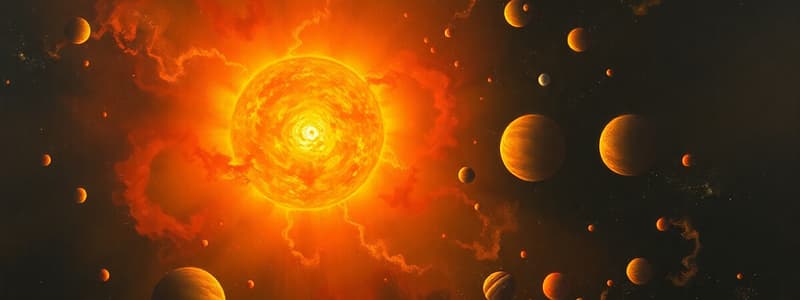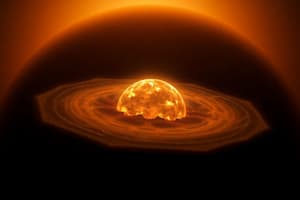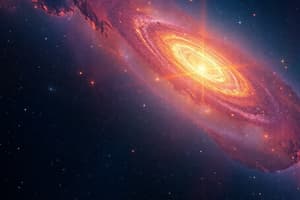Podcast
Questions and Answers
What is considered the most accepted theory about the origin of the universe?
What is considered the most accepted theory about the origin of the universe?
- Solar Nebula Hypothesis
- Static Universe Theory
- Big Bang Theory (correct)
- Steady State Theory
The Solar Nebula Hypothesis was first proposed by Albert Einstein.
The Solar Nebula Hypothesis was first proposed by Albert Einstein.
False (B)
Approximately how many years ago did the Earth evolve?
Approximately how many years ago did the Earth evolve?
4.5 billion years ago
The ________ Theory describes the evolution of the universe and is the most widely accepted.
The ________ Theory describes the evolution of the universe and is the most widely accepted.
Match the following theories with their descriptions:
Match the following theories with their descriptions:
What percentage of the mass of the nebula is comprised of heavy compounds that formed the inner planets?
What percentage of the mass of the nebula is comprised of heavy compounds that formed the inner planets?
The outer planets consist mainly of rocky materials like iron and nickel.
The outer planets consist mainly of rocky materials like iron and nickel.
Who proposed the Big Bang Theory?
Who proposed the Big Bang Theory?
The distance in the solar nebula where volatile compounds begin to solidify is known as the ________ line.
The distance in the solar nebula where volatile compounds begin to solidify is known as the ________ line.
Match the planets with their classification:
Match the planets with their classification:
What is the age of the universe?
What is the age of the universe?
What hypothesis describes the formation of the solar system?
What hypothesis describes the formation of the solar system?
Who first proposed the Solar Nebula Hypothesis?
Who first proposed the Solar Nebula Hypothesis?
How long ago did the Earth evolve?
How long ago did the Earth evolve?
The inner planets consist of ___, ___, ___, and ___.
The inner planets consist of ___, ___, ___, and ___.
What are the outer planets also known as?
What are the outer planets also known as?
Who proposed the Big Bang Theory?
Who proposed the Big Bang Theory?
The Big Bang Theory suggests the universe began from a singular point.
The Big Bang Theory suggests the universe began from a singular point.
What evidence supports the Big Bang Theory?
What evidence supports the Big Bang Theory?
The frost line is the distance in the solar nebula where it is too hot for volatile compounds to condense.
The frost line is the distance in the solar nebula where it is too hot for volatile compounds to condense.
Flashcards are hidden until you start studying
Study Notes
Solar Nebula Hypothesis
- The Sun and other objects in the solar system formed from a nebula cloud composed of dust and gas approximately 4.5 billion years ago.
- The rotating nebula cloud formed a large ball at its center, leading to the formation of the Sun.
- The leftover gas and dust formed a rotating disc around the Sun, which later developed into planetesimals, small bodies that eventually merged to form planets.
Inner Planets
- The inner planets, Mercury, Venus, Earth, and Mars, are predominantly composed of heavy elements like iron, nickel, aluminum, and rocky silicates, accounting for only 0.6% of the nebula’s mass.
- Their proximity to the Sun limited their growth, making them smaller and denser, hence called terrestrial or rocky planets.
Outer Planets
- Outer planets – Jupiter, Saturn, Uranus, and Neptune – were formed beyond the frost line, where volatile compounds like water, ammonia, methane, and carbon dioxide could solidify into ice.
- Their abundance of volatile gases like ammonia, methane, and hydrogen earned them the title of gas giants and they are also known as Jovian planets.
Big Bang Theory
- Belgian physicist George Lemaitre proposed the Big Bang Theory in 1927, explaining the origin and expansion of the universe.
- The theory suggests the universe began from a single point of high energy density that rapidly exploded, causing an expansion that is still ongoing 13.7 billion years later.
- Edwin Hubble’s observation of cosmic microwave background radiation in the 1920s provided further evidence for the expansion of the universe.
- The Big Bang theory explains the abundance of hydrogen and helium in the universe, as these elements formed during the initial expansion.
Solar Nebula Hypothesis
- The most widely accepted theory on the formation of the solar system.
- States that the solar system was formed from a nebula cloud, which is a collection of dust and gas.
- This occurred approximately 4.5 billion years ago.
Formation of the Sun
- Gases and dust in the nebula rotated and formed a large ball in the center, leading to the formation of the Sun.
- The remaining gases and dust formed a disc around the Sun, appearing like a giant ball in the middle of a Frisbee.
- Due to gravitational contraction, smaller lumps known as planetesimals began forming.
- These planetesimals eventually coalesced to form planets, including Earth, which is located about 150 million kilometers from the Sun.
Inner Planets
- The inner planets include Mercury, Venus, Earth, and Mars.
- Formed primarily from heavy compounds like iron, nickel, aluminum, and rocky silicates.
- These compounds make up only 0.6% of the mass of the nebula.
- These planets are referred to as terrestrial or rocky planets due to their smaller size and rocky composition.
- They orbit relatively close to the Sun.
Outer Planets
- The outer planets consist of Jupiter, Saturn, Uranus, and Neptune.
- Formed beyond the frost line, the distance in the solar nebula where temperatures are cold enough for volatile compounds to condense into ice.
- They are also known as gas giants due to their abundance of volatile gases like ammonia, methane, and hydrogen.
- They are referred to as Jovian planets, meaning Jupiter-like planets.
Big Bang Theory
- Proposed by Georges Lemaitre, a Belgian priest and physics professor.
- Explains the origin of the Universe and its ongoing expansion.
- The theory states that the Universe originated billions of years ago from a single point of nearly infinite energy density.
- This point violently exploded approximately 13.7 billion years ago, initiating the expansion of the universe.
- Edwin Hubble provided observational evidence for this expansion by observing cosmic microwave background radiation in the 1920s.
Key Figures
- Edwin Hubble provided evidence for the expanding universe.
- The Cosmic Microwave Background (CMB) provides evidence for the early state of the universe, further supporting the Big Bang theory.
Notes
- The abundance of hydrogen and helium in the universe supports the idea that these elements formed during the Big Bang.
- These lighter elements are considered precursors to the formation of more complex structures.
Studying That Suits You
Use AI to generate personalized quizzes and flashcards to suit your learning preferences.





